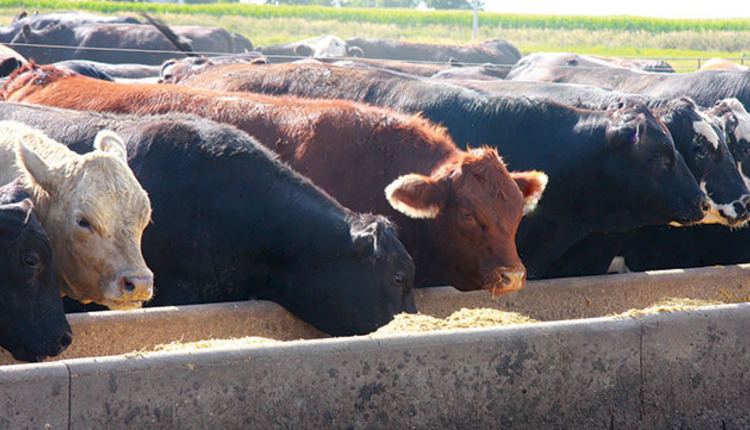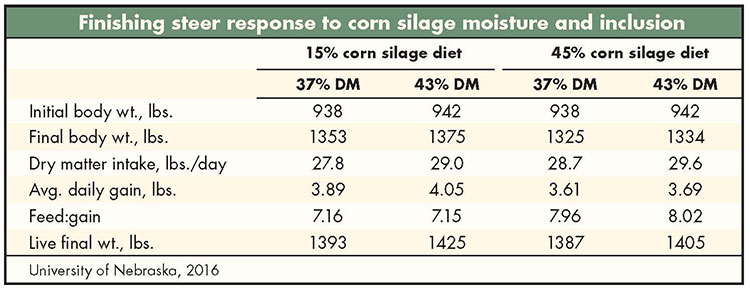
When corn prices are high, corn silage may be a more economical feed to replace a portion of the corn grain in beef finishing diets,” said Galen Erickson, University of Nebraska-Lincoln extension beef feedlot specialist. “Manure and storage shrink loss also play an important role in the overall economic picture,” he added.
With the current situation of tight cattle supplies and expensive feeders, feed costs might be more critical now than in the past due to the large investments required to buy and finish cattle. As a result of this, Erickson evaluated research that explored whether feeding elevated amounts of corn silage and lower levels of corn was economical and could maintain performance and feed conversion. He shared the results at the Silage for Beef Cattle Conference in Mead, Neb.
Corn silage competes
Due to the growing use of distillers grains, he chose to revisit research completed 40 years ago that suggested silage could be fed at a 40 to 60 percent inclusion rate and still be economical, though feed conversion proved poorer. To accomplish this, three feedlot experiments were designed.
One outcome from these experiments showed that corn silage was an equally productive roughage source, if not more so, as cornstalks. “Feeding more than 15 percent corn silage, perhaps 30 to 40 percent inclusion, to replace expensive grain can be economical, especially for a farmer feeder, if manure and its nutrients are applied back onto silage acres and storage shrink is well managed,” Erickson said. This amount of inclusion will, however, hurt feed conversion and depress average daily gain. But if 20 to 40 percent distillers is also fed, the losses will be minimal.
Erickson also conducted literature searches on silage hybrids for beef cattle, as well as kernel processing. He found that silage is significantly less researched for beef cattle nutrition compared with dairy cattle. This creates a challenge for beef producers feeding elevated amounts of silage in finishing diets or growing programs.

Beef cattle are different
Most of the dairy nutrition literature does not apply to beef cattle because dairy cows are consuming about 50 percent or more dry matter (DM) compared to beef. The passage rate is also much higher in dairy cattle, which can limit ruminal digestibility if particle size or grain processing is not optimized. For example, finely ground dry corn has been shown to improve starch digestion in dairy cows, yet leads to acidosis and no production improvements in finishing beef cattle. This difference in responses is presumed to be due to passage rate differences. Erickson emphasized that more research on hybrids, silage production, and kernel processing is needed for beef.
As for hybrid traits, Erickson noted that genetically enhanced hybrids (GMOs) evaluated for traits such as herbicide or insect tolerance reveal clear nutritional equivalence and no impact on digestibility or performance. Data on kernel processing of silage fed to beef cattle is very limited, but in general it has positive attributes for ruminal starch and overall digestibility.
One study conducted at the University of Idaho evaluated the effect of hybrid, maturity, and mechanical processing of corn silage on intake and digestibility of beef cattle. Corn was harvested both when the milkline had progressed halfway or fully down the kernel. Harvesting was done with or without fully active kernel processing using a field chopper.
It was found that the black-layer silages had a higher DM content, as was expected. Starch content rose with maturity, resulting in lower levels of neutral detergent fiber (NDF) and acid detergent fiber (ADF). Processing boosted starch digestibility but reduced NDF and ADF digestibility. Erickson noted that hybrid, maturity, and processing all affect corn silage digestibility.
Harvest targets
The Nebraska beef specialist was recently involved in a similar evaluation of whether ensiling and feeding dryer silage improves performance of both growing and finishing cattle. Silage was harvested at 37 or 43 percent DM and ensiled in silo bags. It was then fed to finishing cattle at 15 or 45 percent of the diet. Feeding the 45 percent silage inclusion diet lowered average daily gain and boosted (worsened) the feed:gain ratio compared to feeding the 15 percent diet.
Harvesting silage at 43 percent DM improved total silage yield and resulted in lower concentrations of ADF and NDF. Feeding the drier silage did not statistically impact dry matter intake, average daily gain (ADG), or feed:gain (see table). It also did not affect any of the carcass characteristics (data not shown). In the 88 percent silage diets fed growing steers, the higher DM silage resulted in slightly poorer performance (2.93 versus 3.19 ADG).
“Based on literature and our research, we suggest targeting a DM for silage between 36 and 40 percent for finishing diets,” Erickson concluded. Milkline markers can be useful, but whole plant DM varies considerably at similar milklines.
Erickson noted that it is a challenge to predict whole plant silage DM while the crop is still standing in the field. Unfortunately, other than milkline, there are really no other useful measures as alternative predictors of optimum harvest time.
This article appeared in the August/September 2017 issue of Hay & Forage Grower on page 12.
Not a subscriber? Click to get the print magazine

